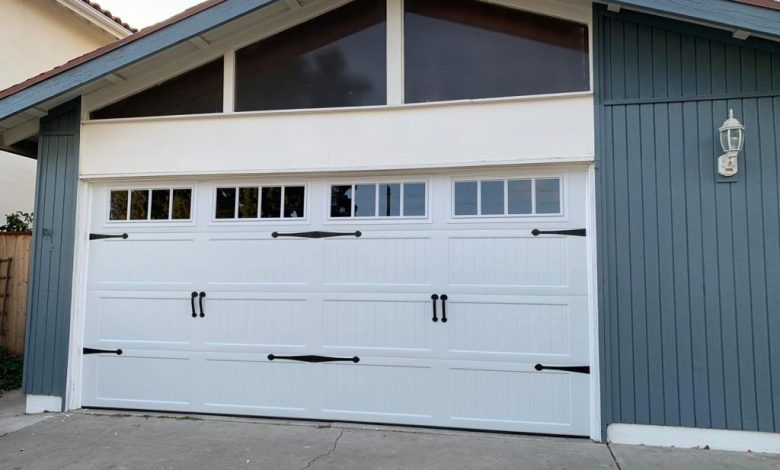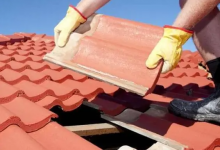When Should A Garage Door System Be Replaced?

Knowing when to replace a garage door system can be tricky, as sometimes a simple repair can fix the problem.
However, some garage door problems require a replacement opener, door, or both. That’s why we’ve outlined which problems can be fixed and which will require replacement, to take the guesswork out of replacing or repairing.
When to Replace a Garage Door System
While there may be times when a simple repair is all it takes to fix a problem with your garage door, more serious problems may require the door and opener to be replaced. Often, if you are replacing a garage door system, everything will need to go along with it.
Garage doors are designed to work with a specific garage door opener and track, so unless you’re entire garage system is new it’s best to replace everything at once to ensure the door works properly. Plus by replacing the entire system you ensure that your warranty will remain valid should another problem arise. Here are some scenarios where it’s better to replace a garage door system rather than repair it.
Scratches on the garage door
If your garage door is getting severely scratched, it might be time to replace the door. If the scratches are deep, the door may start to rust. Once a door rusts, it will definitely need to be replaced, as rust will make the door flimsy and prone to breaking. If it’s just a minor scratch on the surface, you’ll probably be able to continue using the door without problems for some time, as long as the scratches aren’t too noticeable and don’t affect the aesthetics of the door.
Dents in the door
If the door is badly dented, it’s time to replace it. While the door may open and close just fine, it could be causing irreversible damage to other parts of your garage door system. These dents could upset the balance of the door and put extra pressure on the tracks, eventually causing them to break as well. If a car caused large dents by hitting your garage door, we recommend not opening the door until a professional has come out to inspect and trace damage. This type of damage will likely require replacement.
Deformations in the doors
A wooden garage door can warp or crack over time. Once this happens it is irreparable and needs to be replaced. To prevent warping, make sure your wood door is stained or treated on all sides before installation. You may need to re-stain every few years to keep the wood protected from water and moisture.
Physical damage to doors
If the door is physically damaged due to high winds or extreme weather, the door may need to be replaced. Extreme weather can dent a door or even knock it down. These problems can lead to more problems, such as broken springs, tracks, or the actual opener.
Curb appeal
Eventually, your garage door will start to look old, dated, discolored, or sagging. To update the exterior of your home and add curb appeal to your home, replacing that old garage door is a must. A new garage door will add excellent value to your home and have a good return on investment, especially if you’re thinking of selling in the near future. Check here for more details about garage doors services at Precisegds.
Garage door safety
The garage door opener works in conjunction with two photoelectric sensors at the bottom of the garage doorway to detect if something is blocking the path of the garage door. If the sensors detect something, the garage door will automatically lift so it doesn’t crush what’s below. Also, if your garage door was installed before 1993, it probably looks pretty worn by now.
When to repair a garage door system
Sometimes the problems you are experiencing with your garage door may require a visit from a technician to perform some repairs. The following garage door problems require a repairman, rather than a complete illinois garage door repair.
Problem with your transmitters
Transmitters are an integral part of the garage door system and when they’re not working properly, you’ll definitely notice! Sometimes problems arise with your transmitters that prevent the signal from reaching the opener. Be sure to check and replace the batteries if necessary, as this is often the number one reason a transmitter stops working.
Also, check how often your garage door opener is running. Sometimes a neighbor may be using the same frequency for his garage doors as you are for yours, and when he walks by and tries to open his garage door, he opens yours too.
You may think your garage door is malfunctioning by randomly opening and closing, but in reality, it only opens when signaled by someone else. If all else fails for your transmitters, you can reset them by pressing and holding the “learn” button on each transmitter. You may need to refer to your garage door owner’s manual for additional instructions on how to reset.
Photocell sensors are dirty or misaligned.
Two photocell sensors are located at the bottom of the garage door entrance on each side of the door. They point directly at each other and fire an invisible laser through the doorway to identify if there is anything in the way of the closing garage door.
Sometimes one or both eyes get dirty or blocked by something like mud on your car or a spider web growing on it. If this is the case, gently wipe away any dirt or debris with a soft, damp towel. If the garage door still won’t close, the photo eyes are probably misaligned and will need to be readjusted to point directly at each other again.
The track is misaligned.
Over time, the track your garage door runs on can move slightly, causing the track to become misaligned. You may hear a scraping noise at a particular point in the opening and closing cycle, or you may notice the door slows down slightly once it passes a certain point.
This problem is not detrimental to the operation of your garage door, but you certainly don’t want to be operating like this for an extended period of time. If left uncorrected, this misalignment could worsen and cause more serious problems that end up wrecking your entire system. So if you think your track has an alignment problem, get it fixed or call your garage door technician for help right away.
The cables or springs are broken.
While this is a serious and potentially dangerous problem, it probably won’t require you to replace your entire garage door system… However, this is not a DIY project. If there is a problem with the springs or cables, you should definitely turn the project over to a professional.
You’ll know your springs or cables are broken because you’ll hear a loud bang coming from your garage if you’re inside your house. Alternatively, if you are closing your garage door, it will close very quickly and crash to the pavement.
At this point, do not try to open or close your garage door again until a technician has come and fixed it. The cables and springs will definitely need to be replaced, but you should be able to avoid replacing the entire system unless there is also damage to the door, rail, or opener.
Disconnect switch is enabled.
All automatic garage door openers come with a disconnect switch that allows you to safely open your garage door in the event of a power outage. Once this switch or rope is pulled, the garage door is disconnected from the mechanical opener and can be opened manually.
Sometimes this switch can be accidentally pulled or disengaged by a large object you are carrying through the garage. In order for the garage door opener to reopen the door, you will need to reattach the hook of the opener to the garage door.
Types of Garage Door Materials
If the time has come to replace your garage door, there are many options and materials available to choose from in today’s market. Here are five types of materials that are commonly used for garage doors and why they might be a good fit for you.
Metal garage doors
Metal is a good material for sturdy garage doors. It requires less maintenance than a wood door, but dents more easily than a vinyl or composite door. If something dents the door, this could expose it to rust. And once the door rusts, it will need to be replaced.
We recommend that you clean steel doors at least once a year with a household detergent and warm water to remove any build-up that could damage the surface. Steel garage doors are relatively inexpensive, low maintenance, and come in a variety of cosmetic options. They can even mimic the look of a wooden garage door, making them an all-around good choice.
Wooden garage doors
If you are looking for curb appeal then wood may be the material for you. Wood garage doors are highly customizable and come in many different designs and decorative styles, including the popular carport style.
It may be necessary to periodically refinish to ensure the wood remains sealed and water damage does not occur. Wood tends to command a higher price tag than other materials as it requires individual customization and fabrication for each door.
Aluminum doors
Aluminum garage doors generally consist of an aluminum frame with fiberglass inserts. Both are lightweight materials and have good resistance to saltwater corrosion, making them a great choice for someone who lives near the ocean.
However, they do not have excellent insulating properties, so these materials are not normally used indoors. Also, since they are both such lightweight materials, aluminum can be easily dented and fiberglass can be broken by the impact of a car or even a baseball.
There aren’t as many decorative options for vinyl doors as there are other materials, but the cost is often less than other types of garage doors.
Are locks on garage doors necessary?
It may seem obvious that you want to add a lock to your garage door. However, if you have a motorized garage door opener, it may not be necessary at all. These electronic doors and motors work as a lock, and the door is practically impossible to open and close manually.
Many garage door technicians advise against installing locks on motorized garage doors, because it can be easy for a child or friend to accidentally activate the lock. Once hooked, they may try to open the door with the opener, causing irreversible damage to your door.
The lock prevents the door from opening, while the motorized opener tries as hard as it can to pull the door up. This could end up severely damaging the doors or breaking the tracks.
If you don’t have a motorized opener installed on your garage doors, then installing a locking mechanism on the door is very necessary. Otherwise, the doors could be an easy entry for intruders.



